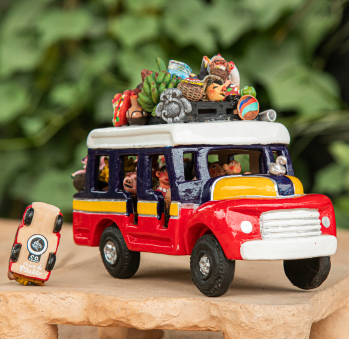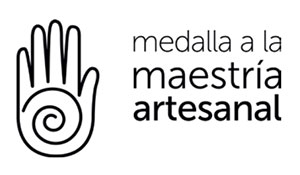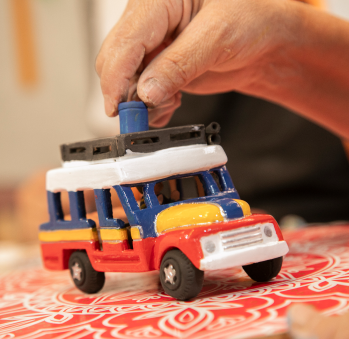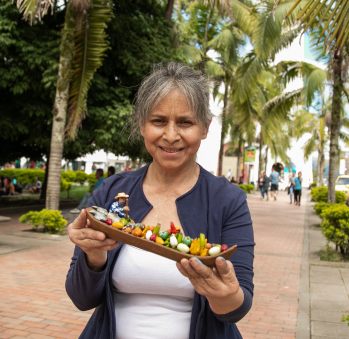Rubiela León
SCHEDULE YOUR VISIT
Transversal 3 # 11 -12 sur Barrio Villa Consuelo, Pitalito, Huila
3138706534
coarpiartesano@hotmail.com
coarpiartesano@gmail.com
@ChivadePitalito
Rubiela aspired to become an aeromechanic. The attention to detail, finesse, and meticulousness demanded by the job intrigued her. She knew that, as a woman, her meticulousness made her a strong candidate, despite any physical strength she might lack; there would always be pulleys. However, life had other plans, leading her to channel her hand dexterity into working with clay, a scent that had always been familiar to her due to her upbringing in a household surrounded by traditional brick manufacturers.
Upon graduating from high school in Bogotá in 1988, she returned to Pitalito. Those years marked the golden era of costumbrist ceramics. Virtually everyone in Pitalito had connections to ceramics, and the city boasted over 800 artisans. The most renowned creation was the chiva, a Colombian bus replica, a skill Rubiela acquired from her mentor, Hernán Bolaños. During that period, clay was sourced from rural estates, extracted with pickaxes and shovels. The first time her teacher guided her in gathering raw materials, she returned home caked in mud, leading to her father instructing her to cleanse herself with alcohol. Nonetheless, she mastered clay extraction from strata and hand-shaped the components of chivas piece by piece: the vehicle itself, sacks, banana bunches, grills, and orchids.
Rubiela chose ceramics. She earned a decent living while raising her daughter amid chivas, nativities, ranches, canoes, and arks. Yet, the mid-nineties marked the end of the golden era. With the surge of narcotrafficking in Colombia, Pitalito turned into a crucial point on the route for coca traders heading north. Numerous craftsmen in Pitalito shifted from ceramics to trafficking. According to Rubiela, this period witnessed the convergence of factors such as significant cash flows, easy profits, and nationwide violence. All of this led to the decline of craftwork. Those who persevered in claywork faced devaluation of their products, isolation, and no support from local authorities or institutions.
The unavoidable mutation of their practice came, in the first place, when they could no longer pick their own clay from the estates. Brick companies began extracting clay on a large scale, forcing artisans to purchase from them. They also had to industrialize their methods, replacing handcrafting with casting. The sole constant is the painting process. Each piece is still individually painted with vinyl paint or enamels before being assembled inside and outside the chiva’s framework.
Though she can no longer extract clay herself, years of practice have endowed Rubiela with the ability to differentiate clay types by sight or smell alone. She discerns which type might explode in the kiln and which is suited for pouring, pressing, or manual molding. As persistent and stubborn as she is, she has imbued her creations with her personal touch, allowing them to stand out. For instance, she secured the Appellation of Origin stamp for her chivas, attesting to their quality. Another achievement is her dedication to reviving Pitalito’s Pot Street and its four pottery wheel masters. This is her resistance—an embodiment of aeromechanic precision merged with potter’s hands, defending her unique identity and that of her fellow craftsmen.
Craft


















Artisans along the way
Artisans along the way
No puede copiar contenido de esta página





























































